Jessica Knauss's Blog, page 23
April 6, 2015
Great Writers of New England: The Adamses
"Writer" might not be the first category we put John Adams into, with all his other accomplishments. But, as we see especially in the correspondence excerpts that David McCullough's biography brought to the general public, he and his wife, Abigail, wrote complex ideas clearly and with conviction. The whole family loved books and contributed beautiful words along with their important works.
New Englanders from the beginning to the end in spite of their travels, the three most important places John and Abigail lived are all in Quincy, Massachusetts, today.
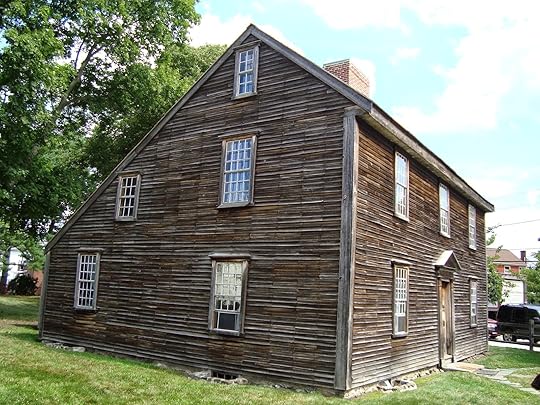
 The "birth home," maintained with the look of the plain boards John Adams's father used to build it, is where John Adams was born and lived for some time. No photos of the interior are permitted, but inside, it's roomier and brighter than it seems like it will be. The light-colored walls and sparse furnishings contribute to a balanced sense of space and allow the visitors' imaginations to soar. Inside, where no photos were allowed, it was easy to picture studying law books or writing correspondence.
The "birth home," maintained with the look of the plain boards John Adams's father used to build it, is where John Adams was born and lived for some time. No photos of the interior are permitted, but inside, it's roomier and brighter than it seems like it will be. The light-colored walls and sparse furnishings contribute to a balanced sense of space and allow the visitors' imaginations to soar. Inside, where no photos were allowed, it was easy to picture studying law books or writing correspondence.
A second birth home at the same site is where John Quincy Adams was born.

 Farther out, the "Old House at Peace field," which the Adamses purchased after their time abroad while John was an ambassador. Abigail is said to have thought the house was too small and dark after the grand European mansions and had extensive renovations done. Both John and Abigail died here. The Adams family lived here for four generations, until the mid-twentieth century.
Farther out, the "Old House at Peace field," which the Adamses purchased after their time abroad while John was an ambassador. Abigail is said to have thought the house was too small and dark after the grand European mansions and had extensive renovations done. Both John and Abigail died here. The Adams family lived here for four generations, until the mid-twentieth century.
 This tree was already in the garden when the Adamses moved here, and each generation enjoyed strolling under its shade. Note the support the park service has added for the long limb at right.
This tree was already in the garden when the Adamses moved here, and each generation enjoyed strolling under its shade. Note the support the park service has added for the long limb at right.
 Under all the ivy is the Stone Library, which holds a breathtaking array of books from the family's personal collection and writings. Each generation produced its own scholar/writer. Before he was president, John Quincy was a lawyer who defended the slaves in the Amistad case. His wife, Louisa Catherine, was so learned and sophisticated that she was able to masquerade as Napoleon's sister and get her family out of France to safety.
Under all the ivy is the Stone Library, which holds a breathtaking array of books from the family's personal collection and writings. Each generation produced its own scholar/writer. Before he was president, John Quincy was a lawyer who defended the slaves in the Amistad case. His wife, Louisa Catherine, was so learned and sophisticated that she was able to masquerade as Napoleon's sister and get her family out of France to safety.
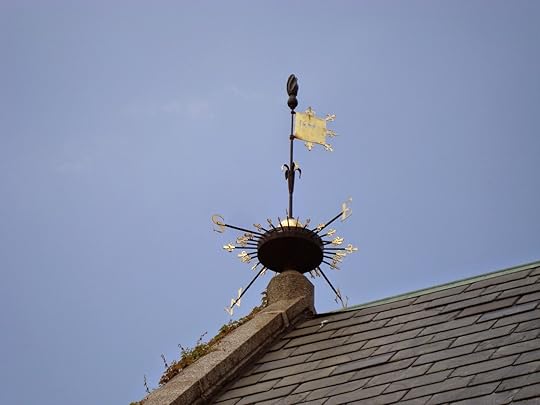 The Stone Library features a weathervane salvaged from a 1666 church.Charles Francis Adams was ambassador to Great Britain during the Civil War, helping the Union win. Charles Francis Adams Jr. became lieutenant colonel of the Fifth Massachusetts Cavalry, an African American regiment during the Civil War. Following in the footsteps of his grandfather and great-grandfather, he wrote moving letters home. Finally, Brooks Adams was a great historian of his distinguished family. The most intense user of the Stone Library, he played a large role in establishing these homes as historic sites.
The Stone Library features a weathervane salvaged from a 1666 church.Charles Francis Adams was ambassador to Great Britain during the Civil War, helping the Union win. Charles Francis Adams Jr. became lieutenant colonel of the Fifth Massachusetts Cavalry, an African American regiment during the Civil War. Following in the footsteps of his grandfather and great-grandfather, he wrote moving letters home. Finally, Brooks Adams was a great historian of his distinguished family. The most intense user of the Stone Library, he played a large role in establishing these homes as historic sites.
All the Adamses valued the written word not per se, but for the way it could make the world, and specifically the United States, a better place. They are some of the most inspiring writers in the history of New England.
New Englanders from the beginning to the end in spite of their travels, the three most important places John and Abigail lived are all in Quincy, Massachusetts, today.

 The "birth home," maintained with the look of the plain boards John Adams's father used to build it, is where John Adams was born and lived for some time. No photos of the interior are permitted, but inside, it's roomier and brighter than it seems like it will be. The light-colored walls and sparse furnishings contribute to a balanced sense of space and allow the visitors' imaginations to soar. Inside, where no photos were allowed, it was easy to picture studying law books or writing correspondence.
The "birth home," maintained with the look of the plain boards John Adams's father used to build it, is where John Adams was born and lived for some time. No photos of the interior are permitted, but inside, it's roomier and brighter than it seems like it will be. The light-colored walls and sparse furnishings contribute to a balanced sense of space and allow the visitors' imaginations to soar. Inside, where no photos were allowed, it was easy to picture studying law books or writing correspondence.A second birth home at the same site is where John Quincy Adams was born.

 Farther out, the "Old House at Peace field," which the Adamses purchased after their time abroad while John was an ambassador. Abigail is said to have thought the house was too small and dark after the grand European mansions and had extensive renovations done. Both John and Abigail died here. The Adams family lived here for four generations, until the mid-twentieth century.
Farther out, the "Old House at Peace field," which the Adamses purchased after their time abroad while John was an ambassador. Abigail is said to have thought the house was too small and dark after the grand European mansions and had extensive renovations done. Both John and Abigail died here. The Adams family lived here for four generations, until the mid-twentieth century. This tree was already in the garden when the Adamses moved here, and each generation enjoyed strolling under its shade. Note the support the park service has added for the long limb at right.
This tree was already in the garden when the Adamses moved here, and each generation enjoyed strolling under its shade. Note the support the park service has added for the long limb at right. Under all the ivy is the Stone Library, which holds a breathtaking array of books from the family's personal collection and writings. Each generation produced its own scholar/writer. Before he was president, John Quincy was a lawyer who defended the slaves in the Amistad case. His wife, Louisa Catherine, was so learned and sophisticated that she was able to masquerade as Napoleon's sister and get her family out of France to safety.
Under all the ivy is the Stone Library, which holds a breathtaking array of books from the family's personal collection and writings. Each generation produced its own scholar/writer. Before he was president, John Quincy was a lawyer who defended the slaves in the Amistad case. His wife, Louisa Catherine, was so learned and sophisticated that she was able to masquerade as Napoleon's sister and get her family out of France to safety. The Stone Library features a weathervane salvaged from a 1666 church.Charles Francis Adams was ambassador to Great Britain during the Civil War, helping the Union win. Charles Francis Adams Jr. became lieutenant colonel of the Fifth Massachusetts Cavalry, an African American regiment during the Civil War. Following in the footsteps of his grandfather and great-grandfather, he wrote moving letters home. Finally, Brooks Adams was a great historian of his distinguished family. The most intense user of the Stone Library, he played a large role in establishing these homes as historic sites.
The Stone Library features a weathervane salvaged from a 1666 church.Charles Francis Adams was ambassador to Great Britain during the Civil War, helping the Union win. Charles Francis Adams Jr. became lieutenant colonel of the Fifth Massachusetts Cavalry, an African American regiment during the Civil War. Following in the footsteps of his grandfather and great-grandfather, he wrote moving letters home. Finally, Brooks Adams was a great historian of his distinguished family. The most intense user of the Stone Library, he played a large role in establishing these homes as historic sites.All the Adamses valued the written word not per se, but for the way it could make the world, and specifically the United States, a better place. They are some of the most inspiring writers in the history of New England.
Published on April 06, 2015 00:30
March 30, 2015
Brilliant Flash Fiction Prize Winner!
 Photo by Laurie Scavo for Brilliant Flash Fiction I came upon an interesting contest in
Brilliant Flash Fiction
in which writers should create a story in 1000 or fewer words after contemplating this sunny, peaceful photo. The result, "Stairs to the Beach," isn't peaceful or sunny, but it won the prize!
Photo by Laurie Scavo for Brilliant Flash Fiction I came upon an interesting contest in
Brilliant Flash Fiction
in which writers should create a story in 1000 or fewer words after contemplating this sunny, peaceful photo. The result, "Stairs to the Beach," isn't peaceful or sunny, but it won the prize!I'm surprised and flattered and thrilled to be so honored.
I'm usually peaceful and sunny, myself, so how did this disturbing set of words come about? First, I asked who would live in such a house? Who would have a use for such an ingenious system to get to the beach below?
As soon as I hit on the name "Josie," this song got stuck in my head.
So Josie is an amazing person, a humanitarian doctor, with a spirit so generous, she adopts ten children and provides them with a fun way to get to the beach they live for. She's away a lot on humanitarian missions, so when she comes home, everyone rejoices. Perhaps it's the way the photo darkens around the edges, or the unusual nature of the tunnel, or perhaps the house reminds me a little of the beach house at the end of Road to Perdition, because then I wondered, what if Josie doesn't come home? What happens to her good intentions then?
The inheritors of her estate (and ten children) aren't interested in charity work or parenting, and so the story took on its life. These characters have a lot in common with Emily from "Unpredictable Factors in Human Obedience" and another Emily, from the forthcoming Awash in Talent, so I have a feeling this beach house may crop up again in my writing.
That's a smooth version of how the writing went. In reality, the connections didn't get made until I sat down to do the labor of writing. Every time I looked at the story, I added one hundred words and deleted twenty-five. And then, I just added details. But there still seemed to be something missing. I showed it to my critique partners, who were magically able to point out the parts that were still vague, and fixed them just in time for the submission deadline.
Of course I didn't submit it before I showed it to my husband, who laughed uproariously in all kinds of unexpected places. Or were they unpredictable?
 Coming Soon...
Coming Soon... You'll be glad to know that in May 2015, you can get many more wonderful short fictions in my story collection, Unpredictable Worlds. More on that soon.
In the meantime, enjoy "Stairs to the Beach." Thanks! And be sure to check out the other amazing stories at Brilliant Flash Fiction.
Published on March 30, 2015 00:30
March 23, 2015
Great Writers of New England: Robert Frost
 Robert Frost as gourd at the Jack-o-Lantern Spectacular at Roger Williams
Robert Frost as gourd at the Jack-o-Lantern Spectacular at Roger Williams Park in Providence, RI, 2014 Robert Frost's poems are simple. Simple is not easy. The clearest, most apparently simple essay or poem is in reality the product of more blood, sweat, and tears than the garbled philippic of the most erudite academic. His style, so hard to obtain, welcomed many new readers into the world of poetry.
 The farmhouse The Frost farm is in Derry, New Hampshire, not far off the highway my husband and I took last fall during the trip to celebrate our fifth anniversary. We would never have known it was there but for the sign on the highway. Its unassuming nature is what makes it so great.
The farmhouse The Frost farm is in Derry, New Hampshire, not far off the highway my husband and I took last fall during the trip to celebrate our fifth anniversary. We would never have known it was there but for the sign on the highway. Its unassuming nature is what makes it so great. The barn/visitor center Frost lived and worked on the farm from 1900 to 1911, while he taught at the local school and honed the poetic sense that has given us so many enduring poems. Imagine: a day job, a farm, and the hard work of poetry!
The barn/visitor center Frost lived and worked on the farm from 1900 to 1911, while he taught at the local school and honed the poetic sense that has given us so many enduring poems. Imagine: a day job, a farm, and the hard work of poetry! Inside the farmhouse. Let the words pour out!
Inside the farmhouse. Let the words pour out! The beautifully maintained farmhouse is attached to a barn, where you can learn about Frost's family, his work, his fans, and many curious farm implements.
 Whose woods these are I think I know...
Whose woods these are I think I know... Outside, a deep meadow leads into woods that look much the same as they must have in the first decade of the twentieth century, the way Frost would have seen them. You can take a photocopied trail guide or wander at your leisure.

The Frost farm, as well as welcoming poetic pilgrims from all over, hosts regular readings and events, and even holds a poetry contest. The simple presentation allows unencumbered access to why New England is a great place to be a writer.
A lot of Frost's work is now available online. Learn more about the farm today, too!
All photos in this post taken and © 2014 by Jessica Knauss
Published on March 23, 2015 00:30
March 16, 2015
No Turning Back Free Promotion
 In 2013, I was finally able to release to the public the English translation of a book I've had undying faith in for decades.
In 2013, I was finally able to release to the public the English translation of a book I've had undying faith in for decades.No Turning Back is "important" because it's the first description of an underground world of resistance to the fascist regime in Spain in the 1970's. But it's also a thrilling and emotionally satisfying read about one woman's struggle to find her way in a rapidly changing world, influenced by Catholicism, communism, and feminism.
I think there are a lot of readers out there who would enjoy No Turning Back, but they don't know it exists. To that end, I'm running a giveaway. Now through March 22, you can get No Turning Back in Kindle, epub, or pdf (any ebook format you need!) at no cost, simply by going to this link.
All I ask is, if you enjoy it, please post a review and let everyone know!
More about the book:
TOP 5 BESTSELLER, POLITICAL FICTION! The harrowing tale of loyalty and disaffection you won't soon forget!
Barcelona, 1986: The dictatorship is over and life is free and easy. But what if you can’t forget the seventies?
Elisa’s troubled past comes back to her in the form of her ex-husband, Arnau, who needs her help to exonerate a former comrade. Elisa relives her Catholic childhood, her marriage to Arnau, her blind loyalty to the communist cause, her experiments in feminism, and her prison time to create a twentieth-century emotional history of the political Left in Spain. The women who faced so much adversity with Elisa weave their own perspectives and testimonies into hers, making this more than a novel: it’s an important contribution to history that gives a voice to the silenced.
Can Elisa ever leave the path history has carved out for her? Or is there no turning back?
“Followers of contemporary Spanish history … will now have the opportunity to understand some of its complex factors … through Falcón’s unswerving critical appraisal of Spanish politics. … Knauss’s agile and eloquent translation guarantees that the memory of clandestine resistance is no longer consigned to the past or to scholars.”
—from the introduction by Linda Gould Levine, PhD
"I wish US authors felt free to be as fearless as Falcón." —Diane Lefer
"...a moving story of self-discovery. The language/translation is poetic and understated. A worthwhile read." —Martin Hill Ortiz
"...absolutely riveting." —Pamela Lloyd
Read an interview about the translation.
Read a free chapter online.
And get the whole book for FREE here.
Thank you!
Published on March 16, 2015 00:30
March 11, 2015
Castles at Unusual Historicals
 Almodóvar del Río Castle. Photo by Jessica KnaussToday I have a post at Unusual Historicals about a castle, and king, and a cantiga, by way of announcing my latest historical project, stories based on the Cantigas de Santa Maria. Enjoy!
Almodóvar del Río Castle. Photo by Jessica KnaussToday I have a post at Unusual Historicals about a castle, and king, and a cantiga, by way of announcing my latest historical project, stories based on the Cantigas de Santa Maria. Enjoy!
Published on March 11, 2015 00:31
March 9, 2015
Review: Mermaids in Paradise by Lydia Millet
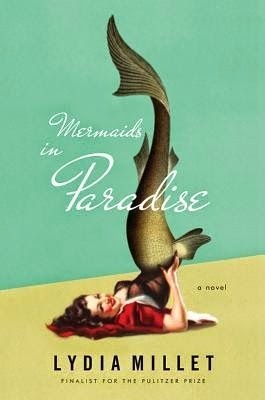 Lydia Millet’s trilogy that began with How the Dead Dream and ended with
Magnificence
has an astounding authorial voice with a knack for choosing the right words and at the same time, it adapts to her chosen protagonist’s thought patterns.
Mermaids in Paradise
, ostensibly fluffier, continues to display Millet’s versatility with a narrator who starts out unsympathetic although comical. As the book goes on, Deb, a new bride on a Caribbean honeymoon with her perfect husband, is drawn into the events and sloughs off the defensive sarcasm she’s learned from her best friend, showing some of her depth and becoming easier to sympathize with.
Lydia Millet’s trilogy that began with How the Dead Dream and ended with
Magnificence
has an astounding authorial voice with a knack for choosing the right words and at the same time, it adapts to her chosen protagonist’s thought patterns.
Mermaids in Paradise
, ostensibly fluffier, continues to display Millet’s versatility with a narrator who starts out unsympathetic although comical. As the book goes on, Deb, a new bride on a Caribbean honeymoon with her perfect husband, is drawn into the events and sloughs off the defensive sarcasm she’s learned from her best friend, showing some of her depth and becoming easier to sympathize with. The plot, too, seems distant and standard for some time. The eventual introduction of the mermaids stands out for the magical description of Deb’s experience, but larger society’s reaction to the mermaids is on the zanier end of predictable.
Then the climax hits like a ton of bricks, giving meaning to the entire novel. I adored the way the mermaids were saved from exploitation. Deb rhapsodizes about the progression of humans from Australopithecines to Homo sapiens, figuring that nothing much happened for five million years, but then came speaking, and then writing, and here we are today, with all the destruction that the technology made possible by writing has wrought.

My takeaway, influenced by the amazing whale-filled climax (and the rash of end-of-civilization literature I’ve been exposed to, no doubt), is that people must not assume we can or should control the natural world. We are part of nature, not separate from it.
And then another unforeseen revelation hits like two tons of bricks, giving another meaning to the novel. Deb could possibly arrive at my takeaway even with this last surprise, but, drugged up after some injuries, she just kind of gives it an “oh well,” which returns us to the meaninglessness of the beginning. Devastating, in typical Millet style. I've seen complaints about the ending, and I assume it's this last-page shocker that bothers others. I don't think it could be a Millet novel without the rug being pulled out from under the reader. The phenomenon fascinates me but turns others off.
Make no mistake: Mermaids in Paradise is a complex novel with incredible expertise behind it. All that and mermaids (and whales!), too!
Novels I've Read in 2015:
 Eleanor & Park
by Rainbow Rowell
Eleanor & Park
by Rainbow Rowell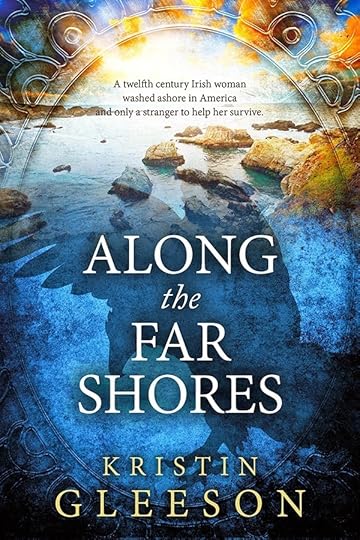 Along the Far Shores
by Kristin Gleeson
Along the Far Shores
by Kristin Gleeson Station Eleven
by Emily St. John Mandel
Station Eleven
by Emily St. John Mandel A Kiss at Kihali
by Ruth Harris
A Kiss at Kihali
by Ruth Harris
Published on March 09, 2015 00:30
March 2, 2015
Review: A Kiss at Kihali by Ruth Harris
 I was amazed to stumble onto a review of
A Kiss at Kihali
, a romance centered around the rhino poaching crisis in Africa. The author expressed a desire to create awareness of the problem through fun fiction. It's an idea I've been kicking around, myself! So of course I had to read it right away.
I was amazed to stumble onto a review of
A Kiss at Kihali
, a romance centered around the rhino poaching crisis in Africa. The author expressed a desire to create awareness of the problem through fun fiction. It's an idea I've been kicking around, myself! So of course I had to read it right away.The novel begins with a chapter from the the point of view of a baby female rhinoceros. It's adorable and ultimately heart-wrenching. I'm not sure words can convey just how cute and goodnatured baby rhinos are, but since I have a good sense of their qualities, the first chapter really drew me in.
The baby ends up at the Kihali orphanage. The saga of the way she's drawn out of her depression to flourish and play with other animals (elephants and a goat, most notably) parallels the way the wounded humans come together and heal each other through their love of animals and each other. The background of the new vet, Starlite, is interesting for the glimpse it gives of how animal theme parks in America operate and the politics of public expectation versus what wild animals actually do. On the whole, however, I didn't find the human relationships very compelling or deeply developed. I haven't read a lot of romance novels, so perhaps I'm not the target audience.
The best part of the novel is the way the baby rhino helps the humans solve the mystery. She more or less testifies with evidence, and then brings about some of the sentencing. That's a pair of wonderful moments I'm sure I won't forget.
I admire the reason this novel was written and hope it fulfills that purpose. Set in Kenya, it's far from the epicenter of the poaching epidemic. This allows the book an optimistic cast (which I appreciate), but leaves a lot for the reader to extrapolate. Please read this book if you'd like to get started on basic rhino facts in a light, playful way.
Novels I've Read in 2015:
 Eleanor & Park
by Rainbow Rowell
Eleanor & Park
by Rainbow Rowell Along the Far Shores
by Kristin Gleeson
Along the Far Shores
by Kristin Gleeson Station Eleven
by Emily St. John Mandel
Station Eleven
by Emily St. John Mandel
Published on March 02, 2015 00:30
February 23, 2015
Madrid's First Rhinoceros
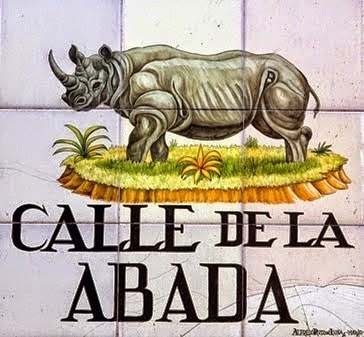
I can’t resist sharing this historical tidbit with you, as it combines my two favorite things: Spain and rhinos.
Tradition has it that Calle Abada in Madrid was named after a sixteenth-century incident in that area. During the reign of Philip II, some Portuguese showmen came to Madrid with an abada,apparently the first way rhinoceroses were referred to on the Iberian Peninsula. The rhinoceros was unknown in Europe, so the showmen stood to earn a great deal by exhibiting him to the public. They set up camp in the fields of the priory of San Martín, in an area now delimited by Calle Preciados, the Gran Vía and the Plaza del Carmen. The locals flocked to the place and paid two maravedís to enter the tent and see the fabulous animal, which they shouted and whistled at while the Portuguese beat drums and bagpipes.
A baker’s son became familiar with the rhino and fed him pieces of bread. One day the boy had the terrible idea of giving the rhino a burning piece of bread, a hot coal, or both together, and the rhino swallowed it. Crazed, the rhino lunged at the boy and killed him before the Portuguese could help it.
As soon as the Prior of San Martín, Fray Pedro de Guevara, found out what happened, he banished the showmen from his lands. In the confusion of the banishment or the shock about the boy’s unfortunate death, the rhinoceros escaped from the Portuguese, and Madrid sent out the alarm. Quevedo (one of the great writers of the time) wrote that as night fell, some warned of a threatening figure near the of San Martín (on the Plaza del Callao) and that officers armed with spears went out to hunt the beast, but it was a false alarm which proved to be a wagon loaded with hay. Others told how a running dog was identified as the rhino and caused many residents to flee in terror. According to legend, the rhino caused as many as 20 deaths during his escape. In the end, the rhino was caught near Vicálvaro by the showmen themselves, with the help of the Holy Brotherhood, an armed corps that may be considered an early modern police.
A wooden cross was erected at San Martín in memory of the boy’s death in the jaws of the rhino. Years later, when the priory of San Martín sold those buildings and houses were built on the site, Calle de la Abada, or Rhinoceros Street, got its name.
The street marker shows a picture of what looks like a black rhino. It would be fascinating to find out where the showmen picked up this wonderful animal, which probably didn't harm any humans intentionally.
Most of this post has been translated from El burgalés by José Montero.
Tune in next week for a review of a rhino novel!
Published on February 23, 2015 00:30
February 16, 2015
Station Eleven by Emily St. John Mandel
 I picked up
Station Eleven
because the sample was rife with Shakespeare quotes and references, and I'm a sucker for those. (See Tree/House if you don't believe me.) After the sample, the relation to Shakespeare is mainly the fact that he lived in a plague-ridden world, like the one in this novel. By the time I got to the sentence explaining that everyone at the theatre would be dead in three weeks, I was hooked on the great writing and a need to know how it would play out.
I picked up
Station Eleven
because the sample was rife with Shakespeare quotes and references, and I'm a sucker for those. (See Tree/House if you don't believe me.) After the sample, the relation to Shakespeare is mainly the fact that he lived in a plague-ridden world, like the one in this novel. By the time I got to the sentence explaining that everyone at the theatre would be dead in three weeks, I was hooked on the great writing and a need to know how it would play out.The novel is constructed around a series of coincidences that center around the actor who dies of a heart attack in the first chapter. Employing dramatic irony to excellent effect, the characters are unable to put all the pieces together, but the reader can. It's for the reader to decide whether the coincidences mean any more than a coincidence normally does simply because of the decreased probability that these artifacts and people could come together in a decimated world. The many characters are lovable, but what I take from the book is a meditation on the meaning of "civilization." Like some other readers, I wondered for a while what the author was doing spending so much time in flashbacks about the actor's life before the end of the world. But it turns out that the vanished civilization is what gives the new supposed wilderness meaning.
What would you miss about civilization? I found the examination of the nasty things left behind to be the most illuminating. Things like the lack of communication all these communication gadgets cause, paparazzi and the culture of celebrity, and going to work every day. The meditation on "work" especially affected me because whether the people enjoyed their jobs or loathed every moment, they became zombies of routine.
Civilization itself is something of a routine. We perpetuate it with our smaller routines, which add up to cultural movements. At one point, one of the characters, in denial about the gravity of the pandemic, says, "Are we supposed to believe that civilization has just come to an end?" The other replies, "Well, it was always a little fragile, wasn't it?" It's a great point. But what they're both missing is that the end of civilization is not the end of the world. Most of the surviving characters settle into communities or tribes that help each other along in this business of living. When, near the end of the book, a ghost in a comic book describes death as having awakened from a dream, I thought he might be describing the common thread in all the characters' experiences of the end of civilization.
The main tribe, a troupe of actors and musicians, has a motto: "Because survival is insufficient." This novel has convinced me that just surviving is unlikely if not impossible. Humans will always make culture, whether it relies on the past or focuses on the present. Station Eleven is a well written, thought-provoking, and memorable novel.
Novels I've Read in 2015:
 Eleanor & Park
by Rainbow Rowell
Eleanor & Park
by Rainbow Rowell Along the Far Shores
by Kristin Gleeson
Along the Far Shores
by Kristin Gleeson
Published on February 16, 2015 00:30
February 9, 2015
Interview with Ron Shannon, Author of The Hedgerows of June
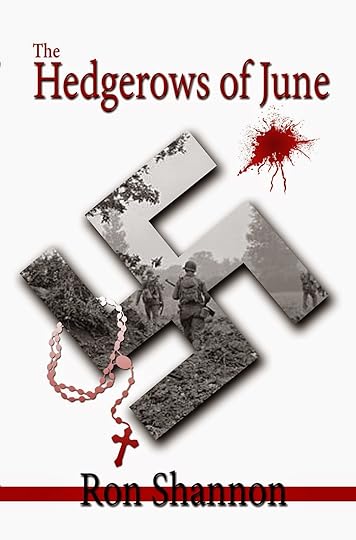
The Hedgerows of June is a suspenseful historical romance centering around the hotly contested Saint-Lô, France, in 1944. A British spy, and American expat, and a French Resistance operative must reunite children with their parents in this war-torn landscape while keeping their own secrets and resisting their own passions.
Today I'm pleased to host the author of this irresistible adventure, Ron Shannon.
JK: Can you fill us in on the historical background of The Hedgerows of June ? What was happening before the story begins?
RS: By late June, 1944, the Allies had taken the beaches of Normandy. The Americans had driven the Germans from the port city, Cherbourg, but not without heavy cost on both sides. The next American objective was to take the town of Saint-Lô, the transportation hub for this part of occupied France. The Germans were determined to defend Saint-Lô because they were convinced it would be the key to the Allies’ victory. The American inland attack would take place in the most inhospitable terrain of Normandy, an area known as the hedgerows.
JK: The Hedgerows?
RS: The Hedgerows are not what we think of when we think of hedges. They are not the hedge plants that are pruned and trimmed into precision cuts.
JK: So it wasn't a garden. Where exactly did the Allies find themselves?
RS: It’s difficult to describe what the Americans encountered as soon as they started their inland attack. This farmland has been around for a millennium or more. The landscape consists of fields bordered by grey rock. Think of a pile of rock running along all four sides of each field. These rock rows are about three feet wide. Growing up through this rock is a mixture of small trees, shrubs, grass and weeds that have grown from three to fifteen feet high. It creates what the French call bocage, an enclosed field with only one narrow entrance.
JK: Are there any roads in this maze?
RS: The roads running alongside the hedges are very narrow, between four or five feet wide. They're dirt roads with deep ruts from the traffic of horse-drawn wagons to and from the fields.
JK: How did they transport equipment through there?
RS: Getting equipment down the roads was difficult to impossible. But the difficulties didn’t end there. The summer of 1944 was the wettest summer since 1900. The weather was miserable and the roads were not dirt. They were mud.
JK: Wow. Misery makes for a great setting. What additional challenges did you give the characters?
RS: The characters in The Hedgerows of June are faced with the same problems as the American Army. They must get from a small town on the edge of the Hedgerows to Saint-Lô.
JK: They aren't going into battle?
RS: Not battle, but the war is all around them. It’s like background noise, small gunfire, explosions, and American fighter planes. The characters are trying to stay one step ahead of the Americans, but they are running into the face of the waiting Germans. That’s trouble because the German Army wants their precious cargo—the four children they must get to Saint-Lô.
JK: Where are the Germans?
RS: The Germans are taking up defense positions in the hedges. That means they are finding places to hide in the thick vegetation. The attacking Americans will not be able to hide if they are expected to move forward. They will be wide open.
JK: How can the Americans possibly overcome this no-win situation?
RS: The Americans had no experience with his type of terrain. To say they weren't prepared is an understatement. It would require cooperation between their armor and their infantry, something they were not trained to do.
JK: Did the Americans have any advantage?
RS: Not necessarily. The Germans were experienced. They had knowledge of the terrain and the benefit it offered them to defend the region. They were also very loyal and in some cases the most fanatical soldiers in the field.
JK: Were the Americans were better equipped?
RS: Again, not necessarily. At this point in the war, the German Air Force was pretty much nonexistent. The Americans did have an air force, but remember this is the wettest summer since 1900. The miserable weather made it impossible to fly for either reconnaissance or attack. The German soldier feared the American planes, but the bad weather kept the planes on the ground. The Germans lacked heavy artillery in Normandy, but they had guns. I mention one of their guns in the novel, a rocket launcher, an odd looking thing nicknamed “Moaning Minnie.”
JK: Weren’t there paratroopers, too?
RS: Paratroopers did land behind enemy lines in advance of the attacking Americans, but they were unable to hold their positions. Many of these paratroopers were lost. My story includes a confrontation with a small group of paratroopers. It is a graphic scene that changes one of the main characters. It brings her face-to-face with the horror of this war and how the Germans defended the bocage.
JK: How did the Americans get through in the end?
RS: You can imagine how difficult it was for the Americans to launch their attack into the Hedgerows. Soldiers did use the roads, but tanks were another story. Getting into the fields presented a problem. My characters were forced to crawl into the fields. They were wide open if Germans were hiding in the hedges. The same was true for the American soldier. At first the Americans used dynamite to blast a hole in the hedgerows, but obviously an explosion did not go unnoticed by the Germans. Someone came up with the idea of turning the tanks into plows. They retrieved steel from the traps and blockades used by the Germans to defend the beaches. The Americans welded the steel to the front of the tanks. They literally plowed their way into the fields. American soldiers quickly learned how to use the tanks as shields against enemy fire.
JK: Do your characters encounter all these techniques?
RS: The war catches up to the characters and they are introduced to techniques used on both sides. The war in the hedges is a series of skirmishes between small units as the Americans make their way across this implausible battleground. As I mentioned before, these skirmishes hang in the air like background noise. At times the background noise takes on a life of its own. In one scene, Chris is listening to distant gunfire. He is a musician and he compares it to a call, followed by an answer. It’s small arms fire shared by men in a land that doesn’t care about who they are or why they fight. The land, the bocage, will be there long after they are gone and their causes are forgotten. Or at least that is what Chris determines from what he hears.
JK: Where does it all come together?
RS: The characters’ destination is Saint-Lô. That is the town the Americans want to conquer and that is the town the Germans are determined to defend.
JK: What is the result of the historical Battle of Saint-Lô?
RS: The Americans manage to push back the Germans, but the tenacious Germans do not lose their will to fight. The skirmishes are fierce and bloody. I’ve seen pictures of roads and fields littered with the bodies of soldiers from both sides. Thousands of casualties occur during July of 1944. The Germans are outnumbered and many German soldiers are taken prisoner, but the defenses into Saint-Lô are tight. The Germans are obsessive.
JK: July?
RS: July. I know the title mentions June. That is when the journey and the adventure begin. I didn't adhere to the timeline of the battle. The battle started on July 1, 1944, and Saint-Lô was taken by the middle of August. Even getting into the city was a challenge. The American fighter planes managed to attack. Bombs were dropped; heavy artillery was used as the city crumbled into ruins. The only structure that survived was the church. The city was rebuilt later.
JK: Is the battle important in The Hedgerows of June ?
RS: Yes. The battle for the city brings the characters into town. They're seeking further escape, but they're caught in the war. What happens determines the future of the characters.
JK: How?
RS: This is, among other things, a story about bravery and about accepting your true identity.
JK: So, without spoiling it, the characters survive?
RS: Well, it’s also a romance and a love story. What do you think?
The Hedgerows of June is available at Amazon.
Find author Ron Shannon on Facebook.
Published on February 09, 2015 06:41



